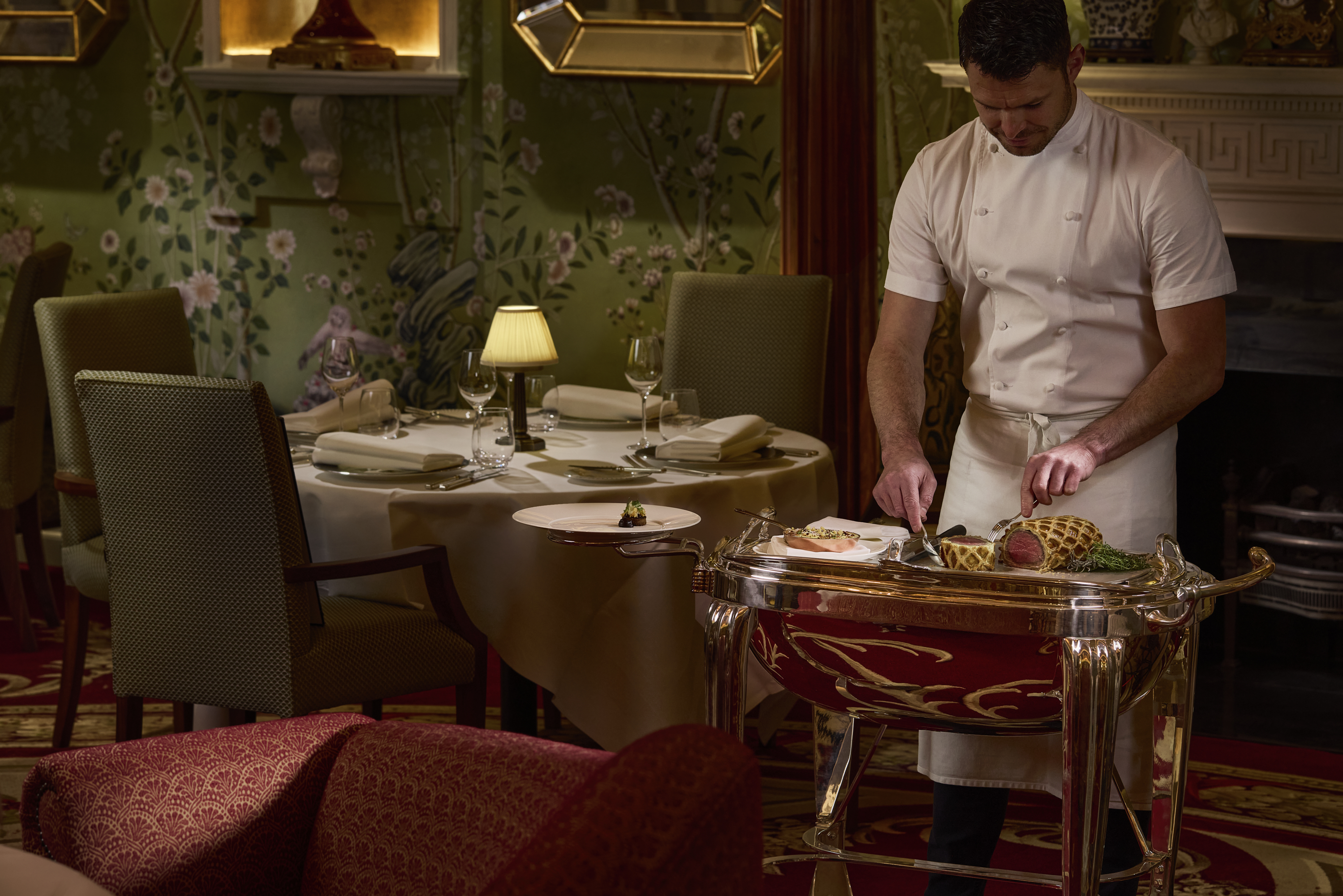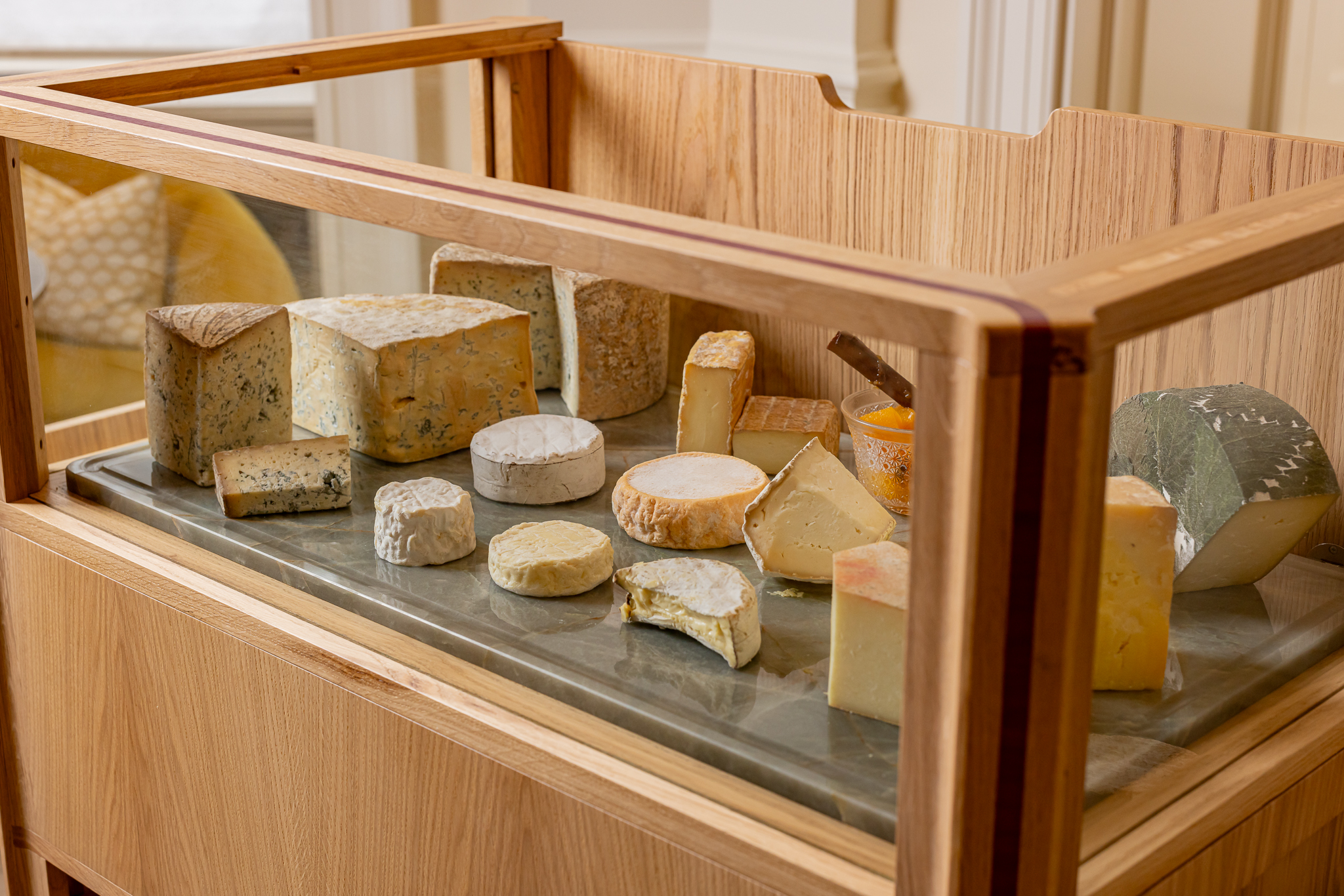From crispy duck to crêpe Suzette, roast beef to rum baba, the arrival of a trolley is the high point of a restaurant meal, as evocative of celebration as balloons and birthday cake. And yet somewhere around the end of the 20th century, trolleys were consigned to the dustbin of kitsch, only permitted to be wheeled out for the cheese course. But fuelled by the post-pandemic realisation that what we missed most about restaurants is the sense of fun and human connection, a trolley is once again a key piece of eating-out equipment, whatever the stage of the meal.
Serving Carts Roll Back Into Luxury Dining
9th December 2024
Once a 1970s staple, luxury dining is now on a roll again with serving carts making a triumphant comeback in the most upmarket establishments.

“I think we all love a trolley,” says Jeremy King. “They have been an important part of my life both as a restaurateur and guest.” The co-founder of The Wolseley and owner of Arlington and The Park intends for trolleys to be the star attraction when he re-opens Simpson’s in the Strand next spring. “I still vividly remember the dishes prepared at my table, such as raspberries Romanoff at Gleneagles, or bananas Foster in New Orleans. Over the years, I have utilised trollies for all sorts of reasons, including tableside preparations, cheeses, baked Alaska and digestifs, and I even commissioned a futuristic trolley for The Ivy from the architect Amanda Levete, back in 1990.”
Fast-forward to 2024 and King cites the dessert trolley at Maison François, a French restaurant in St James’s, as a highlight of eating out in London; the walnut-and-brass cabinet arrives laden with layered gâteau marjolaine, praline Paris-Brest and a daily selection of seasonal fruit tarts.

Two years ago, the sweet trolley was joined by a steak tartare trolley, though owner François O’Neill says the inspiration was American, not French. “One of our influences for Maison François was the TV series Mad Men, in which trolley service and ice-cold martinis were scene-stealers.”
O’Neill estimates that 90 per cent of his customers ask to be shown the dessert trolley; steak tartare fans, meanwhile, “love the fact that they can refine and bespoke their meal,” requesting anything from capers and shallots to Tabasco sauce and anchovy breadcrumbs be added to the mix. Maison François, however, is not the only restaurant to have introduced a savoury trolley.
This sense of historic formality has always found a home in grand hotels such as The Ritz, where a four-course Arts de la Table menu includes trolleys bearing beef Wellington, crêpe Suzette and a tea infusion ceremony that looks and smells like a mobile herb garden. When The Promenade, the all-day dining and afternoon tea lounge at The Dorchester, was unveiled after a full renovation last year, it came complete with trolleys laden with seasonal salads, steak Diane and crêpe Suzette. Halloween will see a pink pumpkin sweet trolley doing the rounds.

A Caesar salad trolley does the rounds at the recently opened Los Mochis London City, a Square Mile outpost of Notting Hill’s Mexican/Japanese mash-up. “It is a little-known fact that the Caesar salad was created by Italian chef Caesar Cardini in Tijuana, Mexico, in 1924,” says Los Mochis founder Markus Thesleff. “We wanted to celebrate this piece of Mexican heritage by offering our own playful twist on the classic dish.” Expect romaine lettuce tossed up tableside not only with Tyrrhenian anchovies and 24-monthaged Parmigiano Reggiano but chilli-lime croutons and nopales (edible cacti).
Once upon a time, most high-society food was served from a trolley. From the Middle Ages onwards, the French aristocracy established the trend for ‘service à la française’, which involved serving various dishes simultaneously from a wooden cart or trolley with diners expected to serve themselves. By the middle of the 19th century, however, the French had adopted ‘service à la russe’, with meals delivered in separate courses by waiting staff, and the finishing touches of a dish applied tableside from a trolley, whether tossing salads, carving meat or flambéing desserts.
“I trust my front-of-house team to perfectly prepare dishes like steak Diane tableside,” explains The Dorchester’s culinary director Martyn Nail. “This level of expertise is rare nowadays and requires a strong collaboration between the kitchen and front-of-house teams to get the service sequence just right.” And, he adds, “It also creates great photo moments.” For what is more likely to bring new customers into an old restaurant than a thirst trap on Instagram?

When the restaurant at The Goring, the only five-star London hotel still owned and run by the family that built it, emerged from a multi-million-pound refit in May courtesy of Russell Sage Studio, a trio of trolleys was part of the design brief for the Edwardian-era dining room. “We have evolved from just being a place to go for lunch or dinner,” says executive chef Graham Squire. “The trolleys make the guest experience more memorable and polished, with us adding decadence and show, so customers leave feeling as though they have been well looked after.” A champagne trolley starts proceedings before beef Wellington is served from a carving trolley. When the rum baba is flambéed tableside at the end of a meal, flames dramatically illuminate the hotel’s new-look dining room, just as fourth- generation owner Jeremy Goring intended. “There’s lots of other tableside services,” Squire adds, “such as adding caviar to our signature Eggs Drumkilbo” – a favourite of the Queen Mother.
The trolley renaissance isn’t simply about indulging a taste for nostalgia, however. At Mauro Colagreco at Raffles London at The OWO, the cheese trolley looks as minimalistically modern as the rest of the dining room. “I wanted to break away from the ordinary cart and work with local artisans to produce a finished product consistent with the restaurant’s design,” Colagreco explains. “Our trolley is based on showcasing the breadth of British cheeses available and UK craftsmanship but served with the savoir-faire of French haute gastronomy.”

Such chic-looking pieces of culinary kit are a stylish reminder of mid-century modern hospitality, when a restaurant’s trolley might have been designed by Alvar Aalto or Jean Royère. Today’s equivalent is Kent-based workshop Rewthink, which has created trolleys for Maison François, The Game Bird at The Stafford hotel in London, Iris in New York, Butcher and Singer in Philadelphia and Lilac in Florida.
Tom Sellers looked even further afield for inspiration when he opened Dovetale at 1 Hotel Mayfair in summer 2023. For his knickerbocker glory trolleys, the chef enlisted the services of Seymourpowell, the design agency responsible for the look of the cabins aboard Virgin Galactic’s spaceships. Named Apollo One and Apollo Two, the trolleys let guests design a bespoke sundae from eight ice creams and an array of toppings, all made in-house and decanted into glasses chilled with a blast of CO2.

Nor are trolleys restricted to European restaurants. The chaat trolley at the new Cinnamon Bazaar in Richmond, like the original in Covent Garden, was handpainted by artist Diane Hill and designed to evoke the carts wheeled through markets in India.
And the trolley trend is set to roll on. This autumn sees the arrival of a tuna trolley at Kioku, the modern Japanese restaurant from chef Endo Kazutoshi atop the OWO hotel. Another rooftop restaurant, Amélie, will have a dessert trolley displaying the menu’s French focus when it opens imminently in Belgravia, with macarons, madeleines and pastries such as peach tart and Paris-Brest.

But the most eagerly awaited trolleys are those returning to Simpson’s in the Strand, where roast beef was once served to Winston Churchill. “We’re having lots of fun imagining how we will use the wonderful trolley flotilla we’ve inherited,” says Jeremy King. “You can expect to see them in action not just for roast beef but also for fish, desserts and more.”
For perhaps it is finally time for Brits to accept the mantle of trolley supremacy passed on from the Russians and French – not least to prevent anything from becoming lost in translation. “My favourite trolley story,” King recalls, “involves a friend who, towards the end of a boozy lunch at L’Ecu de France in Jermyn Street, and finally getting to dessert, asked a waiter ‘can we see your trolley?’ He was met with a blank look. On being pressed further, the waiter eventually returned with a rather shabby old trolley containing all his silver-cleaning equipment.” Not every trolley, after all, is a welcome sight in a restaurant.






